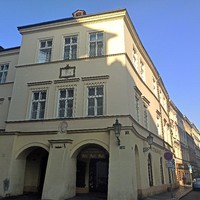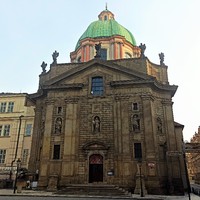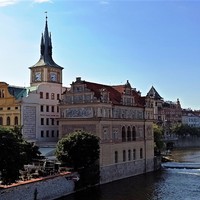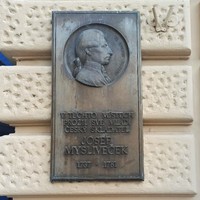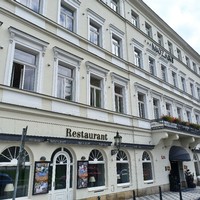Breadcrumbs navigation
Tracing the footsteps of Josef Mysliveček in Prague
Walking route: Old Town Square – house At the Blue Barge – former Theatre in Kotce – Church of St Giles – Klementinum – Church of St Francis of Assisi – Novotného lávka (with a view of Sova’s mills) – Pachtas Palace
It seems a pity that the name of composer Josef Mysliveček (1737-1781) has somewhat faded from wider awareness and is associated more with legends about his adventurous life than with his exceptional music. After all, “il Boemo” (The Czech fellow) was one of the most famous composers of his time, inspired Mozart and worked with leading singers. Josef Mysliveček was born in Prague, where he first became acquainted with music and received his education, not only musical.
Let’s follow the trail left by the composer, whose footsteps turned to Italy after his 26th birthday. He left ‘provincial Prague’ once it became clear he could not make a good living here as a composer. He came back to his home town only once, when he had to settle the family’s affairs after the death of his mother, as her eldest. He wrote 26 compositions of the opera seria genre (i.e. serious operas), a number of oratorios, sinfonias and chamber compositions, and won acclaim in many Italian cities and in Munich.
The first route we have prepared for you leads through the Old Town, where Josef Mysliveček spent a significant part of his Prague life. From the Old Town Square, take Melantrichova street, which comes out opposite the Old Town Astronomical Clock.
→ ① Staroměstské náměstí → ② Melantrichova 13
House At the Blue Barge
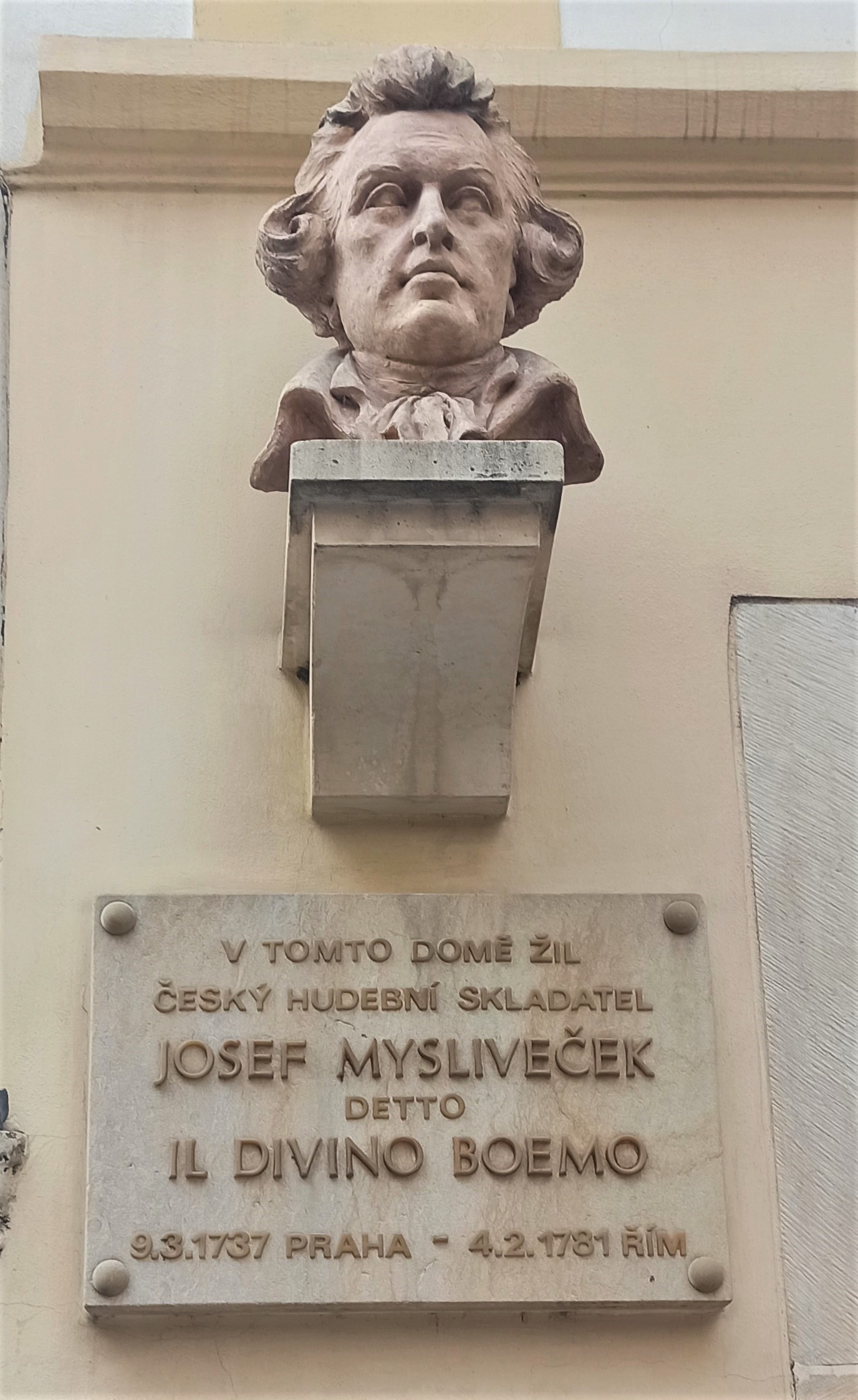
The soon to be famous composer came from a well-established family of a miller of sworn allegiance to the city, Matěj Mysliveček. He belonged to a twelve-man body of experts, appointed directly by the monarch, who formed a de facto expert commission in the millers’ arts. In addition, they were in charge of deciding on all issues related to watercourses and their constructions: weirs, mills, sawmills, etc. The ambitious Matěj Mysliveček was the owner of two Prague mills and later bought a house for his family in the then Sirková street for 2500 gold coins – the street name refers to the fact that sulphur (síra) was sold here in the 18th century – the house At the Blue Barge. It stands where the street turns to the left, and Josef Mysliveček’s stay here is commemorated by a stone bust at the first-floor level. The bust is how the sculptor imagined him: we may never know what Josef Mysliveček really looked like. An interesting feature of the house At the Blue Barge is the fact that at the time of its creation, i.e. in the 14th century, it filled the entire space of the former alley, and therefore does not have its own outer walls. Josef Mysliveček knew the house as we see it today, because the street façade was created by a Baroque modification in the 2nd quarter of the 18th century, when Mysliveček actually lived here.
→ Melantrichova → ③ V Kotcích
Cotes Theatre
From Melantrichova street, continue past the Havelské marketplace, behind which a narrow street with the poetic name V Kotcích will be revealed on the right-hand side. This is where part of the former market hall was located, divided into the cotes [stalls] of individual merchants. Its second part stood on the site of today’s monumental building of the former Prague Municipal Savings Bank. Later, the building lost its original purpose and at the end of the 1830s this second part or so-called Lesser Cotes was transformed into a theatre. It was the first stone theatre in Prague to be built at the expense of the municipality. The theatre operated here from 1739 to 1783, with the exception of 1741–42, caused by the siege of Prague during the Wars of the Austrian Succession. Presented here were stage-plays, puppet shows, mime and ballet works, as well as mainly Italian operas. The performances were in German or Italian. Italian impresarios and theatre producers Pietro Mignotti and Giovanni Batistta Locatelli performed works by their contemporaries and even their own opera pieces. It was the Italian opera that must have greatly attracted Mysliveček’s interest. He may quite possibly have heard the opera Ezio (Aetius) by the Venetian composer Giovanni Battista Pescetti, whom he later sought out and studied with.
The activities of the Cotes Theatre were terminated in 1783 shortly after the opening of the Nostic Theatre; one of the most beautiful theatre buildings in Europe, today’s Estates Theatre, it can be found at Ovocný trh. It is chiefly associated with Wolfgang Amadeus Mozart, who personally conducted his opera Le nozze di Figaro here in January 1787. The opera had been a flop in Vienna, but completely captivated Prague. Mozart returned to Prague in August of the same year to finish working on a new opera. The première of the opera Don Giovanni, which Mozart dedicated to Prague and the people of Prague, took place on 29 October 1787 and was an extraordinary success. In 1791, to mark the coronation of Emperor Leopold II as King of Bohemia, another Mozart opera, in which he returned to the serious genre, was performed at the Nostic Theatre, La clemenza di Tito (The Benevolence of Tito) The same libretto had previously been set to music by Josef Mysliveček in an opera with an identical title.
Europe, today’s Estates Theatre, it can be found at Ovocný trh. It is chiefly associated with Wolfgang Amadeus Mozart, who personally conducted his opera Le nozze di Figaro here in January 1787. The opera had been a flop in Vienna, but completely captivated Prague. Mozart returned to Prague in August of the same year to finish working on a new opera. The première of the opera Don Giovanni, which Mozart dedicated to Prague and the people of Prague, took place on 29 October 1787 and was an extraordinary success. In 1791, to mark the coronation of Emperor Leopold II as King of Bohemia, another Mozart opera, in which he returned to the serious genre, was performed at the Nostic Theatre, La clemenza di Tito (The Benevolence of Tito) The same libretto had previously been set to music by Josef Mysliveček in an opera with an identical title.
→ Rytířská → ④ Uhelný trh
House At the Three Golden Lions
Turn right along Rytířská street and right again through Uhelný trh, featuring the distinctive Wimmer Fountain, to Skořepka street. On the corner house At the Three Golden Lions do at least glance at the portrait relief of Mozart, Mysliveček’s friend; above the first-floor windows is a memorial plaque of white marble with the inscription ‘Mozart lived in this house in 1787’. This is where Mozart was finishing his opera Don Giovanni which was performed with the orchestra conducted by Mozart himself.
→ Skořepka → ⑤ Husova 8
Church of St Giles
At the end of Skořepka, turn right again to Husova street, where after about 100 metres you cannot fail to notice the massive walls of the corner church.
The Church of St Giles and the adjacent Dominican monastery played a crucial role in the life of young Josef Mysliveček. From the age of 6, he most likely attended the so-called ‘normal’ school here, where he first became acquainted with music. In addition to reading, writing & arithmetic, he was also taught unisono choral singing, as well as figural i.e. polyphonic singing. Incidentally, the Church of St Giles has a connection to members of Mysliveček’s family, e.g. his mother Anna Terezie was baptized and buried here. The originally Gothic three-nave church came into Utraquist protestant hands in 1420. In the period after the Battle of White Mountain it went to the Dominicans, who built a monastery in its vicinity and rebuilt the church in the Baroque style. Today, the church is open to visitors and the monastery is once again home to the Dominicans.
→ Husova → Mariánské náměstí 5 → ⑥ Klementinum
Klementinum
After less than 250 metres, Husova street will take us to Mariánské square, whose dominant feature on the left is the impressive entrance wing of the Klementinum, the second largest building complex in Prague. It was this Church of St Clement and the former Dominican monastery that Czech King Ferdinand I availed to the Order of the Society of Jesus (the Jesuits) in 1556. Although the population at that time was almost 90% non-Catholic, upon their arrival the Jesuits immediately founded a college called the Klementinum Academy and began schooling. Subsequently, a Latin school was established at the university dormitory – the Academic Grammar School. The designation referred to a close connection with the University Academy.
The Klementinum complex progressively expanded, in several stages: in the 16th century a new school wing was built, the foundation stone of the Church of St Salvator was laid, and the Italian Chapel built. After the Thirty Years’ War, other parts of the complex were added, including the summer refectory and in the eighteenth century the Astronomical Tower and the Chapel of Mirrors.
Josef Mysliveček attended the Klementinum Academic Grammar School. Subsequently, he enrolled at the Faculty of Arts of the Charles-Ferdinand University in Prague, but did not complete his studies. In the following years, Josef Mysliveček as well as his brother Jáchym were admitted to the Guild of Prague Millers as journeymen, and 3 years later both passed their masters’ exams. However, Josef decided to radically change his career and become a composer. He began to study composition with Prague composers like Josef Seger, the organist at the Church of Our Lady before Týn and in the Church of St Francis Seraph on Křižovnické square, and he soon began composing his own music – of these early compositions his Symphony in C major has survived and testifies to their high standard.
→ ⑦ Křižovnické square
Church of St Francis Seraph
After passing through the Klementinum complex, we will be standing on Křižovnické square in front of the Church of St Francis Seraph (St Francis of Assisi). The northern side of what is said to be the most beautiful square in Prague has had this early landmark Baroque church of the Knights of the Cross with the Red Star since 1685, the decoration of which went on for at least another 70 years. The church is connected with the musical history of Prague through its remarkable Baroque organ, dating from 1702. This pipe-organ is second only to that in the Church of Our Lady before Týn as the oldest in Prague. It was on this musical instrument that five of Mysliveček’s oratorios were performed between 1771 and 78, thanks to the local choirmaster František Tittelbach. These days the church regularly hosts classical music concerts.
→ ⑧ Novotného lávka 1
Novotného lávka
Our next stop will be Novotného lávka, which can be reached from Křižovnické square through the Karlovy lázně passage.
From Novotného lávka let us first enjoy the view across the Vltava river to the left bank, the Prague Castle panorama. As though guarded by statues of penguins, the building across the water in the greenery of Kampa island is Sova’s Mills, named after the original owner Václav Sova of Liboslav. It was there that Josef Mysliveček most likely came into the world on 9 March 1737, followed about an hour later by his twin brother Jáchym. His father Matěj Mysliveček rented the building, later bought it, and subsequently added another building opposite, Kutilův mlýn, on the site of today’s Novotného lávka No. 201.
These days Novotného lávka is more associated with Bedřich Smetana, bearing his statue and housing the Smetana Museum. However, Josef Mysliveček is commemorated here by another memorial plaque, and rightly so. He spent his childhood here, listening to the rhythmic clatter of the mill, the harmony of the flowing river and the strains of song from the mill-workers’ quarters. The depiction of Mysliveček is from the artist’s imagination – no actual likeness of the composer has survived.
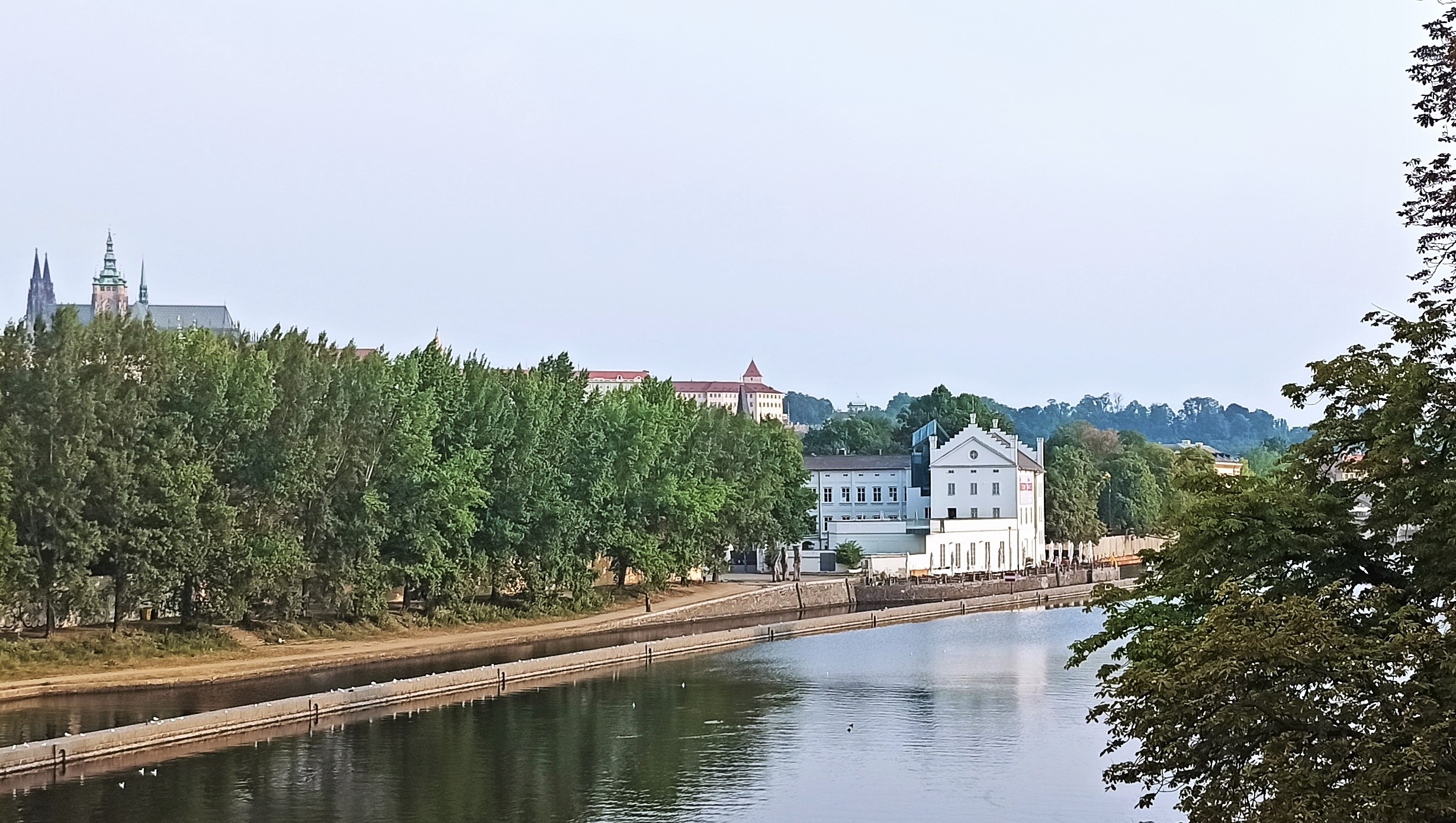
Sova's (Myslivečkovské) Mills, Kampa
→ Smetanovo nábřeží → ⑨ Karoliny Světlé 34
Palace of the Pachtas of Rájov
From Novotného lávka we’ll walk just a few steps to today’s last stop, to commemorate a musician of world renown who was a great admirer of Mysliveček’s work. After all, it is thanks to Mozart and his plentiful correspondence that we have a lot of information about Mysliveček’s life. The Pachtas of Rájov Palace, Nos. 211 and 213 was in its time the true musical hub of Prague, thanks to the patronage of Count Jan Josef Filip Pachta of Rájov (1723-1822). He invited the musical greats of the time to his residence and maintained a wind ensemble composed of his own servants and guest professional musicians. His nephew Jan Josef (1756-1834), who himself composed and participated in the foundation of the Prague Conservatory, was also a significant champion of music.
 Mozart often stayed at the palace during his sojourns in Prague. It is said that Count Jan Josef had Mozart locked in a salon with an upright piano and did not let him go until the Salzburg native wrote several compositions for his ensemble. The story is probably fictional; nevertheless, Mozart did complete his 6 German dances here.
Mozart often stayed at the palace during his sojourns in Prague. It is said that Count Jan Josef had Mozart locked in a salon with an upright piano and did not let him go until the Salzburg native wrote several compositions for his ensemble. The story is probably fictional; nevertheless, Mozart did complete his 6 German dances here.
Josef Mysliveček first met Mozart in Bologna in March 1770 and a strong friendship developed between them. Mozart held him in high esteem (as did his father Leopold Mozart, who hoped that the well-known Mysliveček would open doors for his son in Italy). Josef Mysliveček even wrote Wolfgang Amadeus a letter of recommendation to Jan Josef Pachta, for any prospective visit to Prague.

